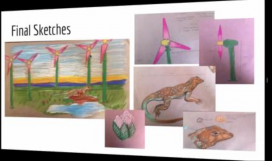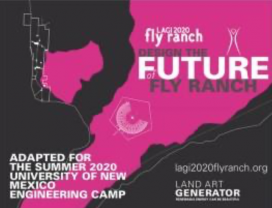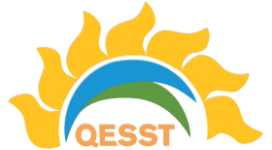QESST UNM Collaborates with Land Art Generator Initiative (LAGI)
Robert Ferry and Elizabeth Monoian, Co-directors of the Land Art Generator Initiative (LAGI) collaborated with Stefi Weisburd, Outreach Coordinator for the Quantum Energy and Sustainable Solar Technologies (QESST), a National Science Foundation (NSF)-funded Engineering Research Center (ERC) to organize engineering design activities for high school students. The QESST project at the University of New Mexico (UNM) School of Engineering was co-sponsored by the U.S. Army Educational Outreach Program (AEOP)’s Unite program, NSF’s Centers of Research Excellence in Science and Technology (CREST) program, and the Department of Energy’s Consortium for Integrating Energy Systems in Engineering and Science Education (CIESESE) project.
LAGI helps design renewable energy infrastructures that are also beautiful places for people. Its efforts focus on fighting climate change while also celebrating human culture and creativity. The long-term goal is to inspire a more rapid and equitable energy transition. Through the QESST collaboration, 41 high school students participated virtually in LAGI’s summer academy with UNM’s School of Engineering. The effort with QESST participants was also designed to support talented high school students from groups historically underserved in STEM.
Students participating in the LAGI summer engineering camp designed solar art inspired by flora, fauna, cultural history and the local landscape of Fly Ranch, a 3,800-acre off-grid ranch in the Great Basin near Black Rock City, Nevada, that serves as a sustainable, year-round incubator for Burning Man culture. The students’ design activities drew upon the LAGI 2020 Fly Ranch design challenge, a global ideas competition that invited innovators and creatives to reimagine Fly Ranch with focus on five primary design categories: POWER: Solar, Wind, Bio, Geothermal, Storage; WATER: Hot Springs, Filtration, Evaporation, Ice; SHELTER: Housing, Event Spaces, Sustainable Architecture; FOOD: Permaculture, Aquaponics, Gardens, Grazing; and REGENERATION: Composting, Recycling, Waste Biogas, Incineration.
The Land Art Generator provides context-specific and culturally-relevant design solutions for distributed clean energy that reflect the needs of local communities. Through the process of designing around land art generators, the high school students show applied understanding of concepts like energy conversion efficiency, and capacity factor, and became familiar with using kilowatt-hours. At the same time they learn to apply knowledge of form, shape, color, and aspects of urban planning and whole systems design. To learn more or to see example proposals for the Fly Ranch site, visit LAGI’s website at: https://landartgenerator.org/competition2020.html.




